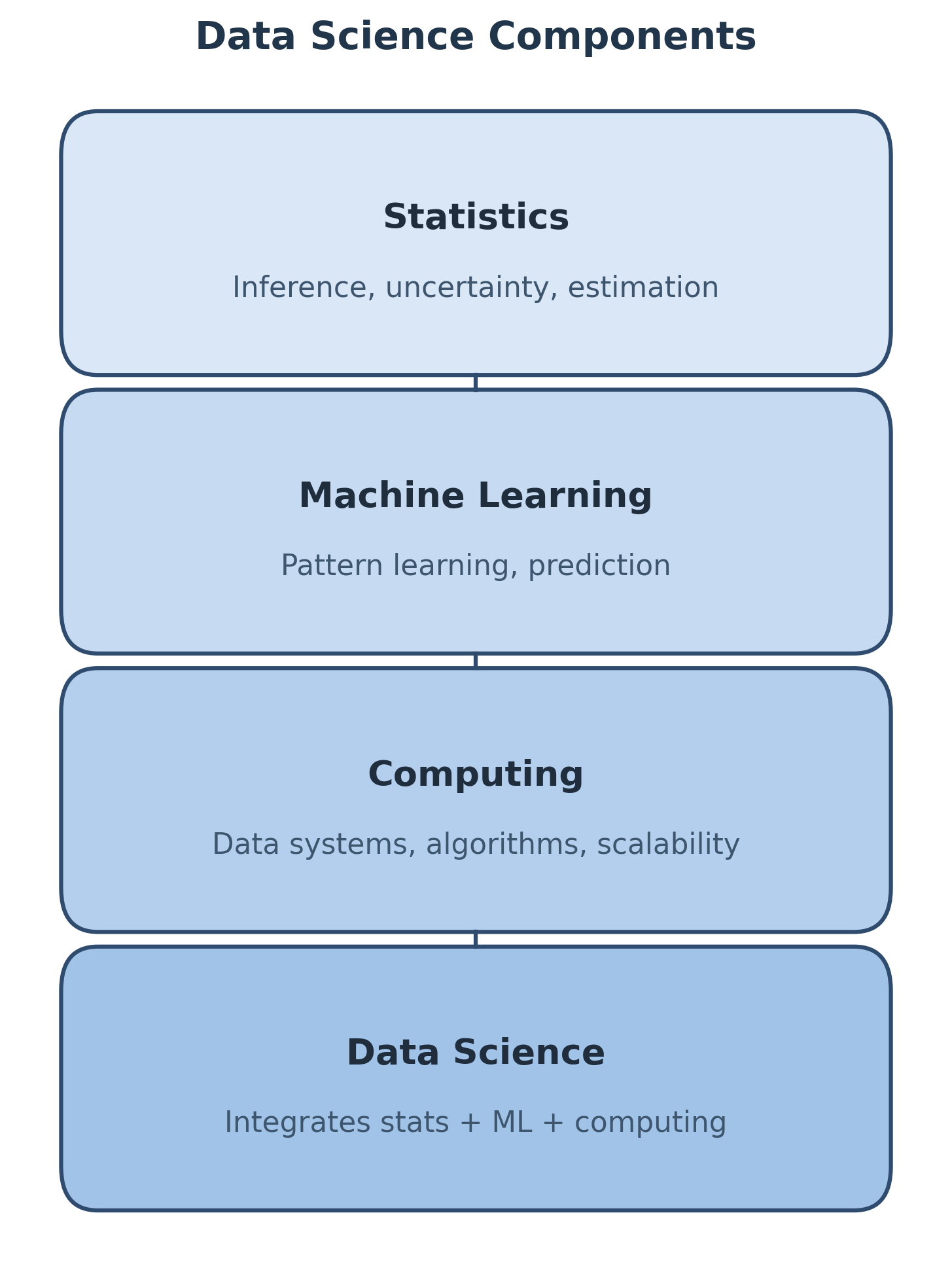📘 Chapter 2 — What is Data Science¶
Data Science is the discipline that integrates statistics, machine learning, and computing to extract knowledge and insights from data.
1. Definition of Data Science¶
Data Science is the study of methods and systems to extract meaningful patterns and actionable insights from structured and unstructured data.
It unites principles from mathematics, statistics, information theory, and computer science.
In simple form, Data Science seeks a mapping:
where: - \(X\) = input or feature space
- \(Y\) = target or outcome
- \(f\) = learned model or pattern
- \(\varepsilon\) = random error or noise
2. Extracting Meaningful Patterns¶
Data scientists explore and analyze large datasets to uncover relationships, trends, and anomalies.
Examples include: - Detecting fraudulent credit card transactions
- Identifying customer segments in marketing
- Finding associations between genes and diseases
The process involves: 1. Collecting and cleaning data
2. Identifying variables and correlations
3. Building models that generalize from examples
3. Building Representative Models¶
A representative model captures essential relationships within the data without memorizing noise.
The goal is to generalize — to perform well not only on training data but also on unseen data.
Steps in model building: 1. Define the problem
2. Select appropriate algorithms
3. Train and validate the model
4. Evaluate with metrics such as accuracy, MSE, or AUC
4. Combination of Disciplines¶
Data Science combines three core disciplines that together enable data-driven decision-making.

| Discipline | Role |
|---|---|
| Statistics | Understanding data distribution, inference, hypothesis testing |
| Machine Learning | Building predictive and adaptive models |
| Computing | Efficient data storage, processing, and algorithmic implementation |
5. Learning Algorithms¶
Learning algorithms form the heart of Data Science. They can be grouped into three major categories:

🧩 Supervised Learning¶
- Learns from labeled data (known input–output pairs)
- Goal: Predict new outputs for unseen inputs
- Examples:
- Spam detection
- Medical diagnosis
- Sentiment classification
🔍 Unsupervised Learning¶
- Works on unlabeled data to find hidden structure
- Goal: Discover natural patterns or clusters
- Examples:
- Customer segmentation
- Topic modeling
- Anomaly detection
🎮 Reinforcement Learning¶
- Learns by interacting with an environment and receiving feedback (rewards)
- Goal: Learn optimal actions over time
- Examples:
- Game-playing AI
- Autonomous robots
- Recommendation tuning
6. Associated Fields¶
Data Science intersects with several related areas that extend its capabilities.

| Field | Connection to Data Science |
|---|---|
| Artificial Intelligence | Broader goal of building intelligent systems |
| Data Mining | Focuses on pattern discovery in large datasets |
| Big Data Analytics | Handles high-volume, high-velocity data streams |
| Cloud Computing | Provides scalable data storage and computation |
| Data Visualization | Transforms analysis results into human-interpretable visuals |
7. Key Takeaways¶
- Data Science integrates mathematics, statistics, and computing for data-driven discovery.
- The process involves extracting patterns, building models, and deploying insights.
- It relies on learning algorithms that can generalize from data.
- Data Science is both a science (theory, inference) and an engineering practice (implementation, scalability).
📚 Suggested Reading¶
- The Elements of Statistical Learning — Hastie, Tibshirani, and Friedman
- Data Science for Business — Provost and Fawcett
- Python for Data Analysis — Wes McKinney